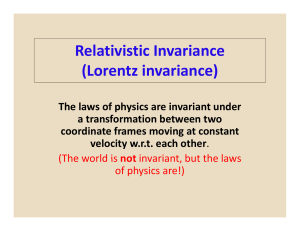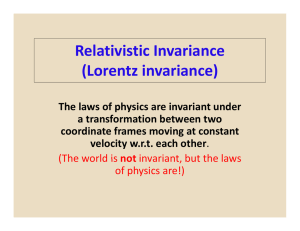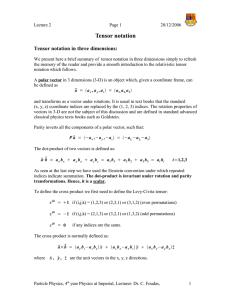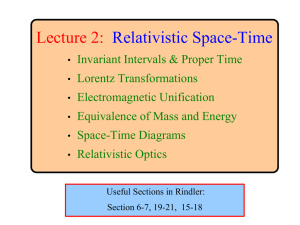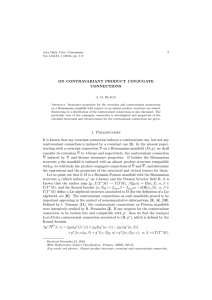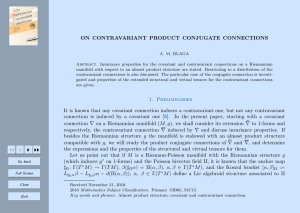Lecture3
advertisement
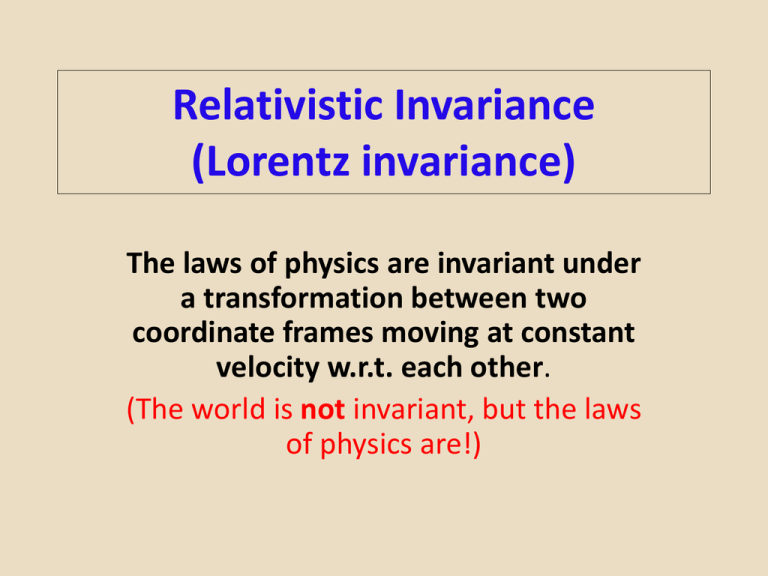
Relativistic Invariance (Lorentz invariance) The laws of physics are invariant under a transformation between two coordinate frames moving at constant velocity w.r.t. each other. (The world is not invariant, but the laws of physics are!) Review: Special Relativity Einstein’s assumption: the speed of light is independent of the (constant ) velocity, v, of the observer. It forms the basis for special relativity. Speed of light = C = |r2 – r1| / (t2 –t1) = |r2’ – r1’ | / (t2’ –t1‘) = |dr/dt| = |dr’/dt’| C2 = |dr|2/dt2 = |dr’|2 /dt’ 2 Both measure the same speed! This can be rewritten: d(Ct)2 - |dr|2 = d(Ct’)2 - |dr’|2 = 0 d(Ct)2 - dx2 - dy2 - dz2 = d(Ct’)2 – dx’2 – dy’2 – dz’2 d(Ct)2 - dx2 - dy2 - dz2 is an invariant! It has the same value in all frames ( = 0 ). |dr| is the distance light moves in dt w.r.t the fixed frame. A Lorentz transformation relates position and time in the two frames. Sometimes it is called a “boost” . • http://hyperphysics.phy-astr.gsu.edu/hbase/relativ/ltrans.html#c2 How does one “derive” the transformation? Only need two special cases. Eq. 1 Transformation matrix relates differentials Recall the picture of the two frames measuring the speed of the same light signal. a b f h a +b f +h Next step: calculate right hand side of Eq. 1 using matrix result for cdt’ and dx’. =1 =0 = -1 c[- + v/c] dt =0 = v/c But, we are not going to need the transformation matrix! We only need to form quantities which are invariant under the (Lorentz) transformation matrix. Recall that (cdt)2 – (dx)2– (dy)2 – (dz)2 is an invariant. It has the same value in all frames ( = 0 ). This is a special invariant, however. Suppose we consider the four-vector: (E/c, px , py , pz ) (E/c)2 – (px)2– (py)2 – (pz)2 is also invariant. In the center of mass of a particle this is equal to (mc2 /c)2 – (0)2– (0)2 – (0)2 = m2 c2 So, for a particle (in any frame) (E/c)2 – (px)2– (py)2 – (pz)2 = m2 c2 covariant and contravariant components* *For more details about contravariant and covariant components see http://web.mst.edu/~hale/courses/M402/M402_notes/M402-Chapter2/M402-Chapter2.pdf The metric tensor, g, relates covariant and contravariant components covariant components contravariant components Using indices instead of x, y, z covariant components contravariant components 4-dimensional dot product You can think of the 4-vector dot product as follows: covariant components contravariant components Why all these minus signs? • Einstein’s assumption (all frames measure the same speed of light) gives : d(Ct)2 - dx2 - dy2 – dz2 = 0 From this one obtains the speed of light. It must be positive! C = [dx2 + dy2 + dz2]1/2 /dt Four dimensional gradient operator covariant components contravariant components 4-dimensional vector component notation • xµ contravariant components • xµ covariant components ( x0, x1 , x2, x3 ) = ( ct, x, y, z ) = (ct, r) µ=0,1,2,3 ( x0 , x1 , x2 , x3 ) = ( ct, -x, -y, -z ) = (ct, -r) µ=0,1,2,3 partial derivatives /xµ = µ 4-dimensional gradient operator (/(ct) , /x , /y , /z) = ( /(ct) , ) 3-dimensional gradient operator partial derivatives /xµ µ Note this is not equal to = (/(ct) , -/x , - /y , - /z) = ( /(ct) , -) They differ by a minus sign. Invariant dot products using 4-component notation contravariant covariant xµ xµ = µ=0,1,2,3 xµ xµ Einstein summation notation (repeated index one up, one down) summation) xµ xµ = (ct)2 -x2 -y2 -z2 Invariant dot products using 4-component notation µµ = µ=0,1,2,3 µµ Einstein summation notation (repeated index summation ) = 2/(ct)2 - 2 2 = 2/x2 + 2/y2 + 2/z2 Any four vector dot product has the same value in all frames moving with constant velocity w.r.t. each other. Examples: xµxµ pµpµ pµxµ pµµ µAµ µ µ For the graduate students: Consider ct = f(ct,x,y,z) Using the chain rule: d(ct) = [f/(ct)]d(ct) + [f/(x)]dx + [f/(y)]dy + [f/(z)]dz d(ct) = [ (ct)/x ] dx = L 0 dx Summation over implied First row of Lorentz transformation. dx = [ x/x ] dx = L dx 4x4 Lorentz transformation. For the graduate students: dx = [ x/x ] dx = L dx /x = [ x/x ] /x = L /x Invariance: dx dx = L dx L dx = (x/x)( x/x)dx dx = [x/x ] dx dx = dx dx = dx dx Lorentz Invariance • Lorentz invariance of the laws of physics is satisfied if the laws are cast in terms of four-vector dot products! • Four vector dot products are said to be “Lorentz scalars”. • In the relativistic field theories, we must use “Lorentz scalars” to express the interactions.
